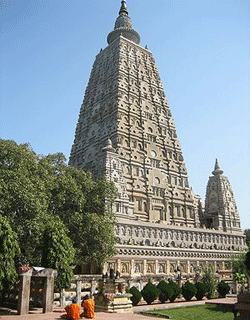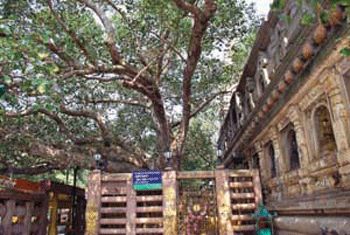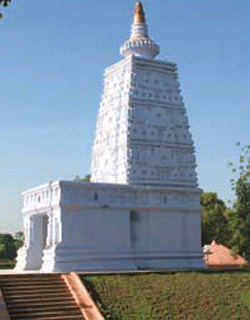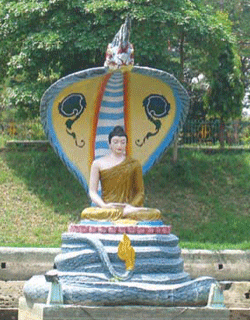The Mahabodhi Temple is a Buddhist temple in Bodh Gaya, the location where Siddhartha Gautama, the Buddha, attained enlightenment. Bodh Gaya is located about 96 km from Patna, Bihar state, India. Next to the temple, to its western side, is the holy Bodhi tree. In the Pali Canon, the site is called Bodhimanda, and the monastery there the Bodhimanda Vihara. The tallest tower is 55 metres tall.
In the 6th century B.C. Prince Siddhartha Gautama attained Supreme Enlightenment at this Holy place and became the Buddha. In commemoration thereof, Emperor Asoka set-up the Vajrasana (Diamond Throne) of polished sandstone representing the seat of Enlightenment in the 3rd century B.C.
Thereafter he built a stupa in veneration of the Buddha which remained there upto the 2nd century A.D. The original structure of Mahabodhi Mahavihara Temple was completed in 7th century A.D. during the reign of Gupta kings. The temple underwent several restorations, renovations and repairs in subsequent period in which the Burmese greatly contributed. In 1883, a very thorough and scientific renovation of the Temple was done under the supervision of the British Archaeologist Sir A. Cunningham and J.D.M. Beglar and the Indian Archaeologist Dr. Rajendra Lal Mitra. Again in 1956, on the occasion of 2500th Buddha Jayanti celebrations, the Govt. of India did some repair works and enlarged the premises of the Mahabodhi Mahavihara. This is the most sacred place of Buddhist Pilgrimage in the world.
The gold painted statue of Buddha in the sanctum shrine of the Temple is made of Black stone built by the Pala kings of Bengal. The Buddha is seen seated in the Bhumisparsa Mudra or the Earth touching posture.
The Mahabodhi Mahavihara has now been declared a World Heritage Site by the UNESCO on the 27th June 2002.
In the Temple complex, one can also visit the other seven places where the Buddha spent in meditation after the attainment of Enlightenment. All these places are situated inside the Temple complex.
The sacred Bodhi Tree
The sacred Bodhi tree – the shades under which the Siddhartha Gautama meditated and attained Enlightenment on the full Moon day of Vaisakh Purnima (May month). This peepal tree’s botanical name is Ficus Religiosa. It was under this tree that the Buddha spent the first week in meditation after attaining Enlightenment.
The present tree is probably the fifth succession of the original tree which was earlier destroyed several times by man-made misery and natural calamities.
Vajrasana
Vajrasana or the Diamond Throne is the seat of the Buddha’s Enlightenment. Built in the 3rd century B.C. by Emperor Asoka, it is made of red sand stone. Venerable Ashwaghosa in his Buddhacarita reveals that this is the Navel of the Earth. Fa-Hien mentions that all the past Buddhas attained Enlightenment here and the future Buddhas too will attain the enlightenment on this spot.
Animesha Lochana Chaitya
Situated on the north east of the Mahabodhi Temple, this is the place where the Buddha spent the second week in meditation in standing posture gazing at the Bodhi Tree with motionless eyes for one whole week.
Muchalinda Sarovar
The place where the Buddha spent the sixth week in meditation after his Enlightenment. While the Buddha was in meditation, a severe thunder storm broke out and seeing the Buddha getting drenched, the snake king of the Lake called Muchalinda came out of his abode and protected the Buddha with his hood from the violent wind and rains.
Tel: 0091 – 631 – 2200735
Fax: 0091 – 631 – 2200777
EMail: mahabodhi@hotmail.com
Website: www.mahabodhi.com









